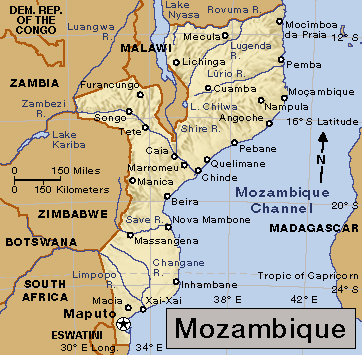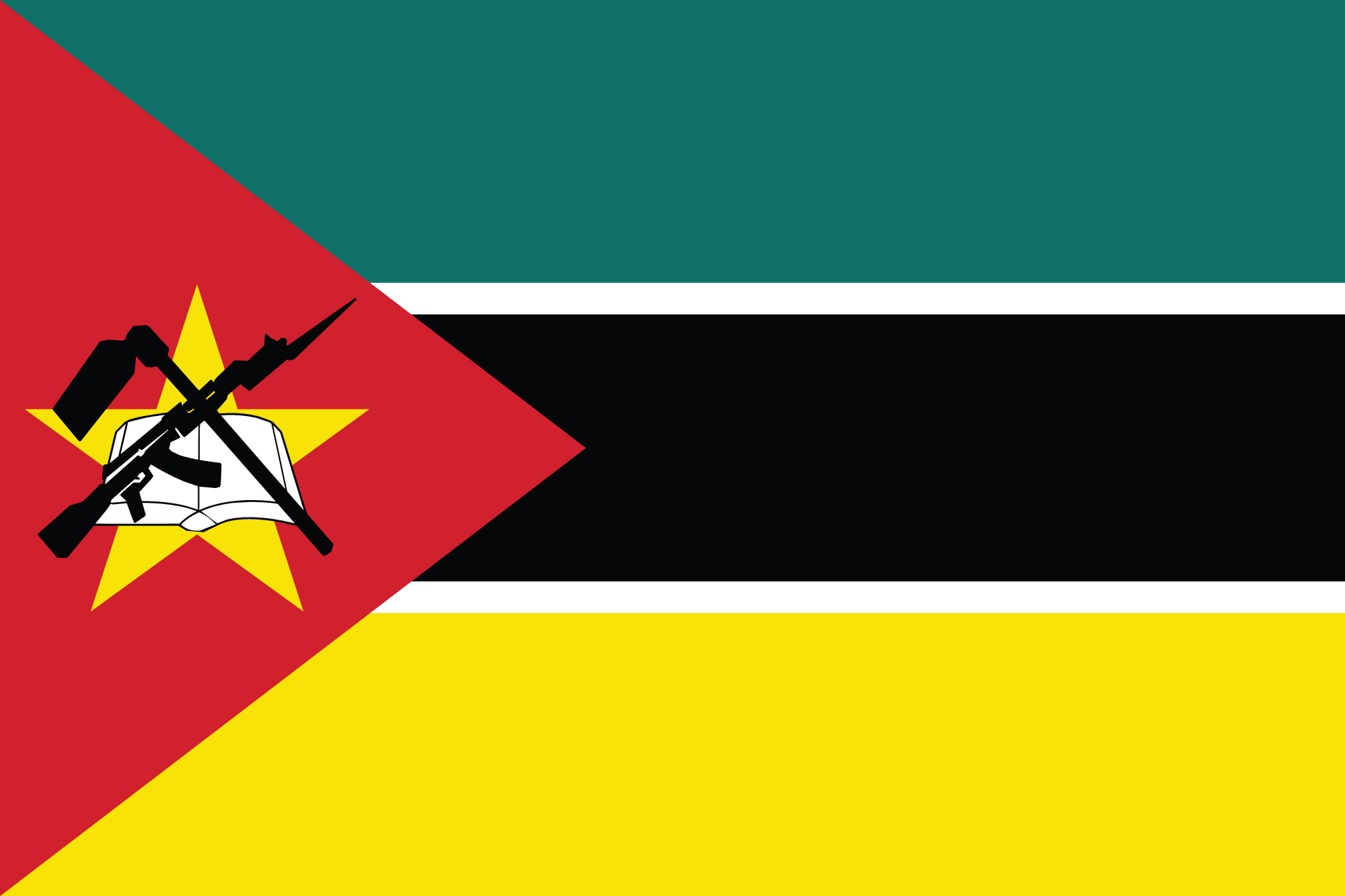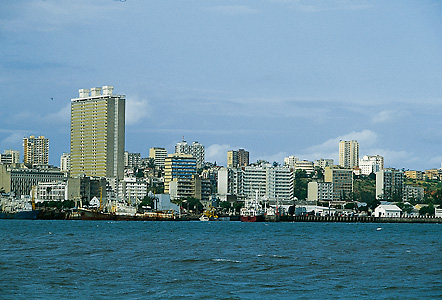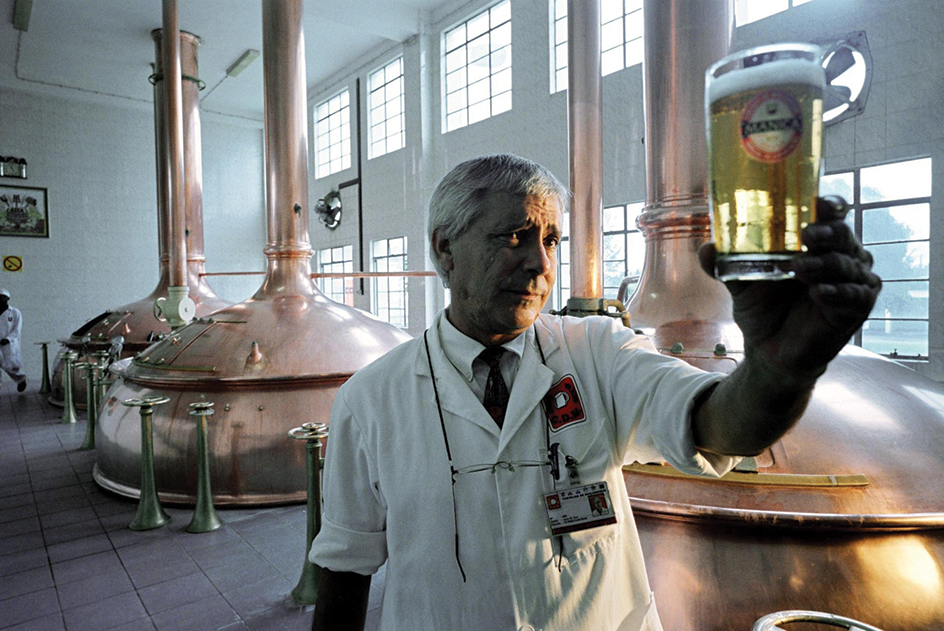Mozambique << `moh` zuhm BEEK >> is a country on the southeast coast of Africa. The country is noted for its many fine harbors. Its port facilities are used by some neighboring countries. Maputo is the country’s capital, largest city, and chief port. Mozambique was governed by Portugal from the early 1500’s until 1975, when it became independent after a 10-year struggle against Portuguese rule.

Government.
The president of Mozambique is the head of state and head of government. The people elect the president to a five-year term. The president appoints a prime minister and cabinet. The prime minister heads the cabinet, which is called the Council of Ministers.

The elected Assembly of the Republic makes Mozambique’s laws. Its members serve five-year terms. The two largest political parties are commonly called Frelimo and Renamo. Frelimo was originally an organization opposed to Portuguese rule. Its full name is the Front for the Liberation of Mozambique. Renamo’s full name is the Mozambican National Resistance.
Mozambique is divided into 11 provinces, including the capital city of Maputo, which has the status of a province. The Supreme Court is the country’s highest court.
People.
Almost all Mozambicans are Black Africans. Most of them belong to groups that speak one of the Bantu languages. The largest group, the Makua-Lomwe, accounts for about 40 percent of the population of Mozambique. Only some people speak Portuguese, the country’s official language. Some Mozambicans speak English in business activities. People of Arab, European, and Indian descent make up less than 1 percent of the population.

Most Mozambicans are farmers, but their techniques are extremely simple. Some farmers use the slash-and-burn method, which involves cutting and burning forest trees to clear an area for planting. Farmers in some areas of the country use more modern techniques.
Many people in Mozambique practice traditional African religions. Many of this group are animists, who believe that everything in nature has a soul. Others worship the spirits of their ancestors. About 40 percent of the people are Christians, mostly Roman Catholics. About 20 percent of the people are Muslims.
Loading the player...Mozambican traditional music
Programs sponsored by the government have significantly improved education in the country. About 60 percent of Mozambique’s people can read and write. A university was established in Maputo in 1962.
Land and climate.
Almost half of Mozambique is covered by a flat plain that extends inland from the coast. The land rises steadily beyond the plain, and high plateaus and mountains run along much of the western border. Sand dunes and swamps line the coast. Grasslands and tropical forests cover much of the country.
Many sizable rivers flow east through Mozambique into the Indian Ocean, and their basins have extremely fertile soil. Cashew trees and coconut palms grow throughout the country. Animal life in Mozambique includes crocodiles, elephants, lions, and zebras.
Mozambique has a basically tropical climate, but temperatures and rainfall vary considerably in different areas. Temperatures average 68 °F (20 °C) in July and 80 °F (27 °C) in January. About 80 percent of the annual rainfall occurs from November to March. The rainfall ranges from 16 to 48 inches (41 to 122 centimeters).
Economy.
Mozambique’s economy is not well developed. Many of the country’s people live in poverty. Foreign aid is an important source of national income.
Agriculture is Mozambique’s major economic activity. Important crops include bananas, cashews, cassava, coconuts, corn, sugar cane, and tomatoes. Farmers raise beef and dairy cattle, goats, and hogs. Some people catch fish and shrimp in the Indian Ocean.
Factories manufacture aluminum, cement, fertilizers, food products, and textiles. Coal is mined in central Mozambique. The Cahora Bassa Dam in the northwest produces electric power, much of which is transmitted to South Africa. 
Most of Mozambique’s roads are unpaved. Several railroads link Mozambican ports with other African countries. The chief airport is at Maputo. Beira and Maputo are the main seaports. Mozambique’s economy depends partly on payments by neighboring countries for the use of railroads and port facilities.
History.
People have lived in what is now Mozambique since around 4000 B.C. Bantu-speaking people settled there before A.D. 100. Arabs lived in the area by the 800’s. Portuguese explorers first visited Mozambique in 1497. They established a trading post there in 1505, and the country became a center for trading enslaved people. But most of Mozambique was undeveloped until the 1900’s.
Through the years, Portuguese control of Mozambique was threatened by Arabs, Africans, and some European nations. In 1885, Africa was divided among various European powers, and Mozambique was recognized as a Portuguese colony. It was often called Portuguese East Africa. Borders similar to those of present-day Mozambique were established in 1891.
Towns and railroads were built in Mozambique during the late 1800’s and early 1900’s, and the Portuguese population rose. In the 1950’s, many Black people became increasingly discontented with white Portuguese rule. Frelimo was established in 1961 as a guerrilla movement. It began military attacks against the Portuguese in 1964 and gained control of part of northern Mozambique. Fighting continued for 10 years.
Portugal agreed in 1974 to grant independence to its colonies. Mozambique became independent on June 25, 1975. Frelimo took over the government, and Samora Machel became the first president. Most of the Portuguese then left Mozambique. Frelimo, at that time a socialist party, began putting major industries under government control. Frelimo also introduced improvements in health care and education.
In 1976, Mozambique closed its border with Rhodesia (now Zimbabwe) in cooperation with United Nations sanctions against that country’s white minority government. This action cost Mozambique much income from Rhodesian use of its railroads and ports. Many Black Rhodesians fled to Mozambique to use bases there in their fight against the Rhodesian government. In 1980, Black people gained control of Rhodesia’s government, and the country’s name was changed to Zimbabwe.
Mozambique also aided guerrilla forces that opposed the white minority government in South Africa. South Africa gave aid to guerrillas fighting against Mozambique’s government. In 1984, the two countries signed a treaty in which they agreed to stop aiding the guerrillas. But the guerrillas in Mozambique, called the Mozambican National Resistance (Renamo), continued fighting there. The fighting disrupted farming and other economic activities. In 1986, Machel was killed in a plane crash, and Joaquim Chissano became president. In 1994, a multiracial government gained control of South Africa.
In the 1980’s, Mozambique’s government decided to permit an increase of private enterprise. It helped people start their own businesses and began a shift from government-run farms to private and family-run farms.
In the 1980’s and early 1990’s, droughts and the disruption resulting from the war with Renamo caused food shortages that led to malnutrition and starvation for millions of people. Frelimo and Renamo signed a peace agreement in 1992. Frelimo had been Mozambique’s only legal political party until 1990, when a new constitution was adopted. New parties began to register legally in 1992. Mozambique held its first multiparty election in 1994. Chissano won the presidential election. He was reelected president in 1999.
In 2000, Cyclone Eline and heavy rains struck Mozambique, causing widespread flooding. About 700 people died, and about 500,000 were left homeless. Severe floods struck again in 2001, killing about 100 people and leaving more than 200,000 homeless. 
In 2004, Armando Guebuza of the ruling Frelimo party was elected president of Mozambique. Guebuza was reelected in 2009. Government troops and Renamo forces clashed in 2012 and 2013. In 2014, delegates from Renamo and Frelimo worked to reestablish peace. Frelimo’s Filipe Nyusi was elected president in elections held that October. He took office in February 2015. Tensions remained high, however, and Renamo forces began launching new attacks in early 2016.
In March 2019, Cyclone Idai hit central Mozambique and neighboring Malawi and Zimbabwe with strong winds and rain. Flooding and destruction killed about 600 people in Mozambique. More than 6,700 suspected cholera cases were reported there as a result of the storm, and more than 48,000 malaria cases. A second huge storm, Cyclone Kenneth, struck less-populated areas in northern Mozambique in April, causing widespread destruction and more deaths and disease. Mozambique had never been hit with two such powerful storms in the same season since record-keeping began. 
New peace agreements between the government and Renamo were signed in August 2019. In October, Nyusi was elected to another term as president. Despite the peace agreement, tensions between the government and Renamo remained high. In addition, attacks by Islamist militants upon civilians in Mozambique’s northern Cabo Delgado province began to increase in 2020. The attacks, which began in 2017, were thought to be related to the discovery of large natural gas deposits in the area. More than 700,000 people have been displaced due to the violence.
